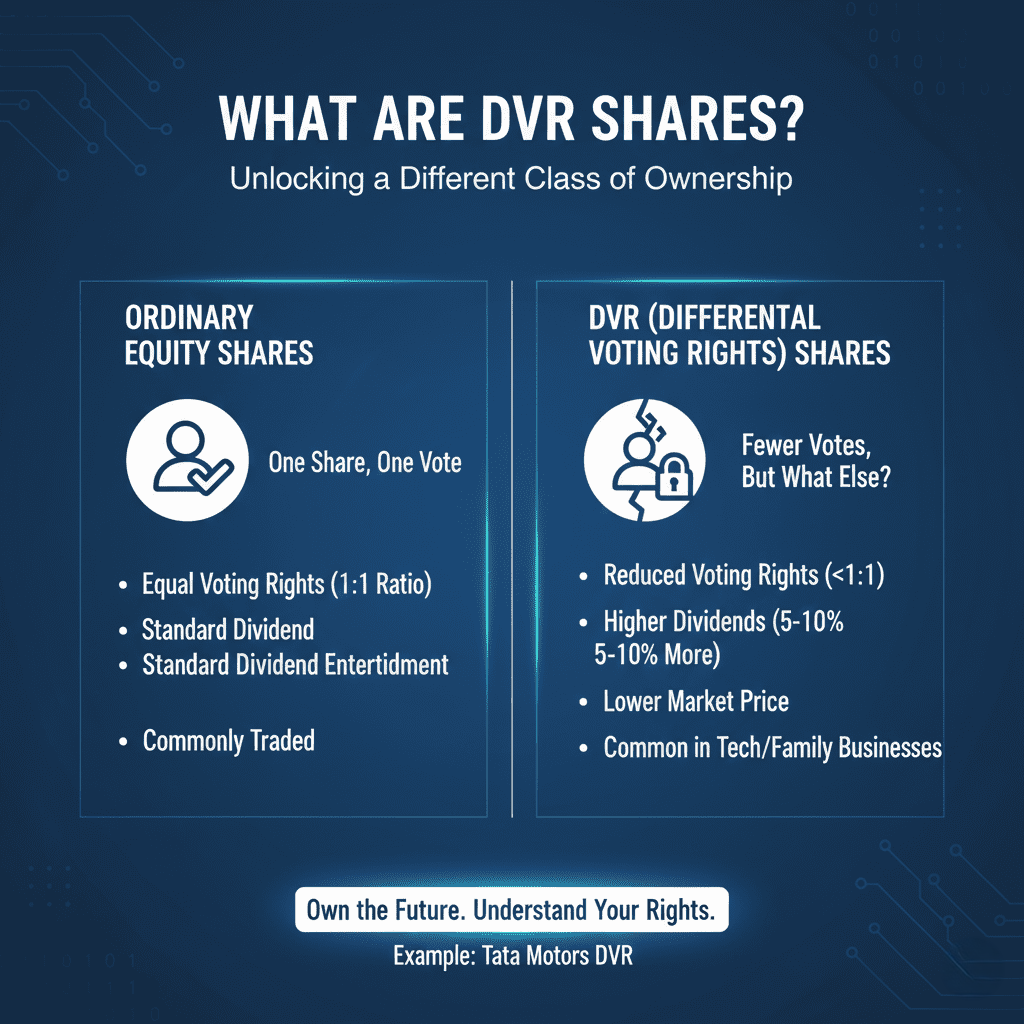



What Are DVR Shares?
DVR (Differential Voting Rights) shares are equity shares that carry different voting rights compared to regular equity shares. In India, DVRs typically come with lower voting rights. For example, 1 vote for every 10 shares instead of the standard “1 share = 1 vote.”
The trade-off?
Investors may get higher dividends or discounted valuations in return for reduced governance power.
Why Do Companies Issue DVR Shares?
Think of DVRs as a corporate control strategy. Companies deploy DVR shares to:
• Raise capital without diluting promoter voting power.
• Protect against hostile takeovers.
• Attract investors who care more about economic returns than board influence.
• Support founders in fast-scaling businesses by keeping decision-making centralized.
For high-growth companies—especially tech and consumer brands—DVRs offer growth capital minus governance chaos.
Regulatory Framework for DVR Shares in India
India’s DVR ecosystem is tightly governed to ensure balance between control and investor protection. Key points:
• Companies must have Articles of Association permitting DVR issuance.
• Shareholder approval is mandatory.
• Earlier cap of 26% DVR capital has been relaxed for startups—limit now up to 74% voting power in special cases.
• Issuers can’t freely convert ordinary shares into DVR shares.
• Superior Voting Rights (SVR) allowed only under strict SEBI norms (executive role, sunset clause, etc.).
This governance guardrail keeps the structure transparent and investor-safe.
DVR Shares vs Ordinary Shares
|
Parameter |
DVR Shares |
Ordinary Shares |
|
Voting Rights |
Lower or fractional |
Full voting (1:1) |
|
Price |
Usually at a discount |
Fair market value |
|
Dividend |
Often higher |
Standard dividend |
|
Liquidity |
May be lower |
High liquidity |
|
Target Investor |
Passive investors |
Investors wanting influence |
Benefits of DVR Shares for Investors
DVRs offer a specific value proposition:
• Lower price entry → Easy access to quality stocks.
• Higher dividends in many cases → Designed to compensate for reduced voting rights.
• Economic participation remains the same as ordinary shares (bonus, rights, splits).
• Ideal for passive, long-term investors who focus on returns, not board decisions.
Risks & Limitations
Like every equity instrument, DVRs come with trade-offs:
• Minimal voting power → No meaningful say in company decisions.
• Lower liquidity → Buying/selling volumes may be thin.
• Corporate governance concerns → Promoter control may overshadow minority interests.
• Discount persists → Price gap vs ordinary shares may never fully close.
Examples in India
Tata Motors DVR is India’s best-known case study.
These shares historically traded at a significant discount to the regular Tata Motors stock but offered a 5% higher dividend, making them attractive to value investors.
Who Should Consider DVR Shares?
DVRs align well with:
• Long-term investors focused on capital appreciation + income.
• Retail investors seeking exposure to blue-chip companies at lower price points.
• People who don’t care about board influence but want economic participation.
• Investors building high-dividend portfolios.
Who should avoid DVRs?
Anyone who prioritizes control, governance influence, or liquidity.
Final Takeaway
DVR shares bridge two worlds: company control and investor accessibility. They let companies scale without losing strategic direction, and they give investors a discounted stake in strong businesses.
If you’re a passive investor with a value mindset, DVRs can be a smart addition to your equity stack—just watch liquidity, governance quality, and the discount-to-ordinary gap.